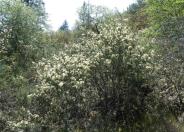
Common name:Pacific Madrone
Botanical name:Arbutus menziesii
One of the most attractive of all California broadleafs, Arbutus menziesii, or Pacific Madrone, has a straight, smooth trunk of 60' with lovely red bark highlighted by shiny green foliage and showy white flowers.

Common name:Douglas Iris
Botanical name:Iris douglasiana
Douglas iris is an evergreen perennial for shade or partial sun with blue violet spring flowers. It is a California native that is drought tolerant.
-Cornflower Farms

Common name:California Fescue
Botanical name:Festuca californica
The California fescue is a cool season bunchgrass with blue-green blades that reach 2 ft. high. The flower stalks are 5 ft. tall and create fountain-like clumps. This grass is drought tolerant for sun and shade. The California fescue is native to California and is a beneficial insect plant. -Cornflower Farms

Common name:Buck Brush
Botanical name:Ceanothus cuneatus
Ceanothus cuneatus is a species of flowering shrub in the Rhamnaceae (Buckthorn) family known by the common names Buckbrush and Wedgeleaf Ceanothus. This Ceanothus is native to Oregon, California, and northern Baja California, where it can be found in a number of habitats, especially chaparral. It is one of the most common and widespread native plants in California. It is a spreading bush, rounded to sprawling, reaching up to 3 meters in height. The evergreen leaves are stiff, tough and fleshy, and may be slightly toothed along the edges. The bush flowers abundantly in short, thick-stalked racemes bearing rounded bunches of tiny flowers, each about half a centimeter wide. The flowers are white, sometimes tinted strongly with blue or lavender.
Designer: UC Berkeley
Photographer: Vicki Anderson
Incorporate compost 6" into your soil to retain water, reduce compaction, feed earthworms, and provide valuable nutrients to your plants.
Remove irrigation water and fertilizer from areas where you don't want weeds to grow.